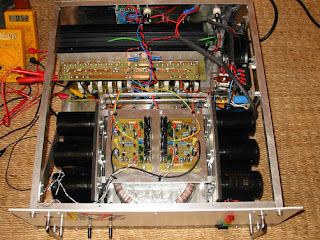
I propose here a more powerful version of the 200 Wrms 8 ohms AB class power amplifier project. It shares the same concept that the less poweful model : assembled using common compoments (not very expensive), based on traditional diagrams : a symmetrical differential input stage, a cascode stage driver and a MOSFET output stage. The printed circuit board is very compact , and is composed of two subsets : the command stage and the output stage. All resistors are 1/4 watt 1 % metal film (except if otherwise stated). Constant current sources of +/- 1 mA are formed around T5 and T6. The diodes D1 to D6 allow the use of low noise transistors type BC550C and BC560C, the transistors T7 to T10 form the stage driver. The potentiometer P1 allows the adjustment of the quiescent current to 100 mA per output transistor. The symmetrical power supply is entrusted to a large transformer of 750 VA, 2 * 60 volts + bridge rectifier and 8 reservoir capacitors of 4700 µF, which gives an output voltage of + and - 85 volts per rail. A 1000 VA transformer is necessary for maximal continuous output power at 4 ohms. The output power is 360 Wrms under 8 ohms or 550 Wrms under 4 ohms. Distortion is lower than 0,02 %, damping factor is better than 400, signal-noise ratio is 112 db (balanced A at full power), the input sensitivity is 1,2 volts (360 W under 8 ohms).
Diagram :
The capacitor C3 is not reproduced on the diagram and on the PCB (it is correct).
Proposal of the command stage PCB :
Transistors T9 and T10 must be assembled on a common heatsink with 5° c/w thermal resistance or on the output stage heatsink.
Proposal of the output stage PCB :
The points marked A, B and C have to be connected between the two PCBs. The ground (earth) points of PCBs and loudspeaker ground (earth) must compulsorily be connected in star with the 0 Volts of the PSU. The power transistors must be assembled on a heatsink with a termal resistance less than 0.5 ° C/W. They must also be electrically insulated from the heatsink by using a mica insulator + heat-conducting compound or a silicone insulator.
Bandwidth :
Bandwidth is limited from 5 Hz to 53 Khz (at - 3 db) by the input module (C1, R1, C2, R2). It can be modified according to the application desired. It is useless to increase the bandwidth to the botton (bass) because little useful signal is present at the bottom of the spectrum. In public address sound systems the bandwidth is often limited between 20 and 35 Hz. The loudspeakers are thus protected against too high extreme-bass signals and some more power is available for the remainder of the spectrum. Michael Eveleigh (UK)
Source : http://users.swing.be/edwinpaij/ampli_mosfet_360_w.htm





Comments
Post a Comment